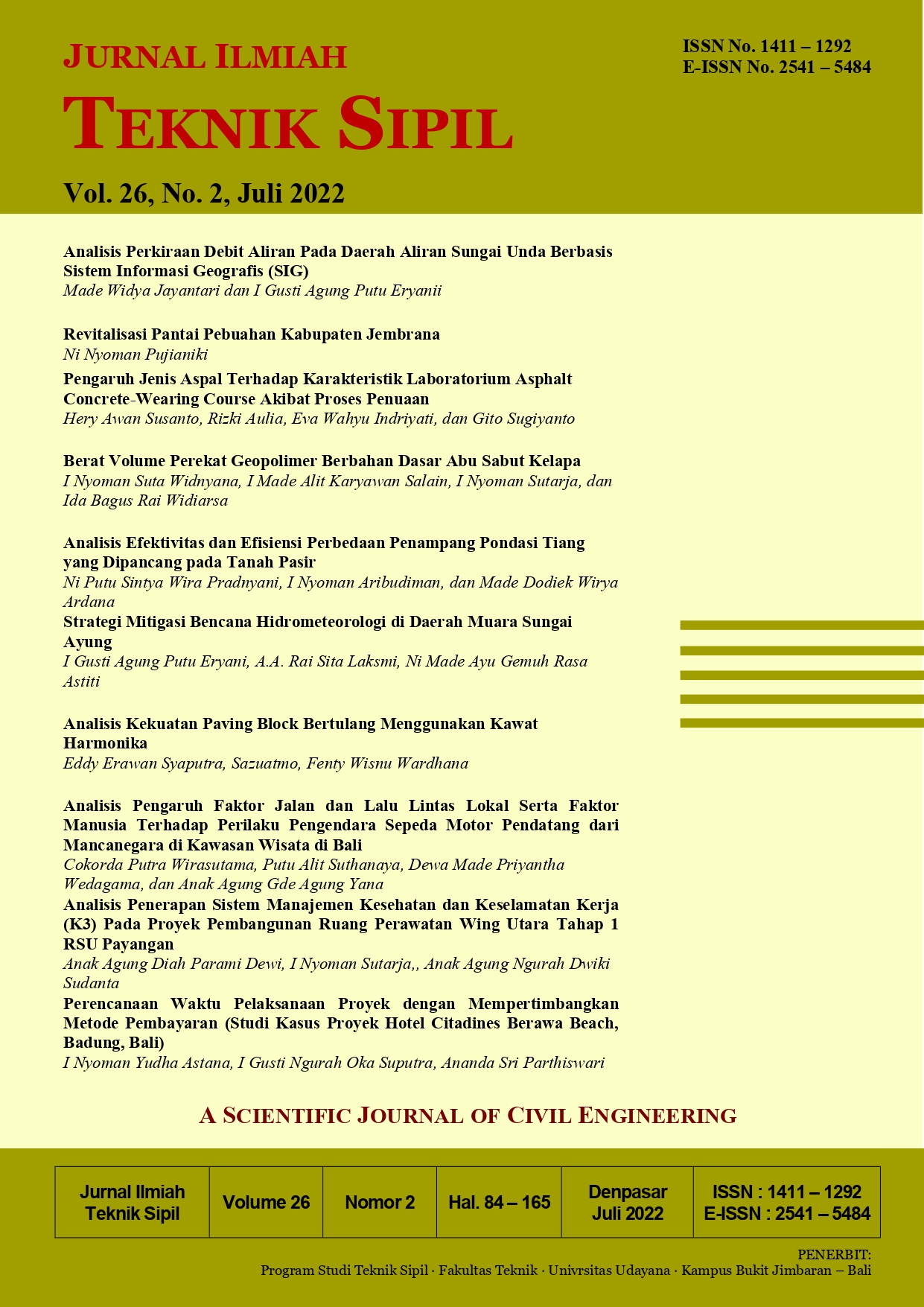ANALISIS PERKIRAAN DEBIT ALIRAN PADA DAERAH ALIRAN SUNGAI UNDA BERBASIS SISTEM INFORMASI GEOGRAFIS (SIG)
Abstract
Keterbatasan data aliran merupakan kendala yang sering terjadi di dalam analisis ketersediaan air. Untuk mendapatkan data tersebut dewasa kini sudah banyak model-model prediksi debit aliran. Teknologi penginderaan jauh (remote sensing technology) dapat meningkatkan pengembangan studi model hubungan curah hujan–limpasan secara konvensional. Dengan teknologi ini dapat membantu dalam memprediksi debit limpasan untuk tiap Sub-DAS. DAS Unda merupakan salah satu DAS Potensial di Provinsi Bali. Analisis debit aliran ini dilakukan dengan metode overlay dengan mengoverlay peta tata guna lahan dan peta jenis tanah di DAS Unda sehingga mendapatkan nilai CN kemudian dilanjutkan dengan menghitung debit aliran prediksi menggunakan metode SSCN. Dari analisis dalam sepuluh tahun terakhir terjadi fluktuasi debit, dimana debit terbesar yang pernah terjadi adalah 10.569 m3/dtk pada tahun 2013 di subdas Telagawaja dan terendah sebesar 0,079 m3/dtk di subdas Tanah pada tahun 2010. Untuk subdas Telagawaja dalam sepuluh tahun terakhir debit rata-ratanya sebesar 8,068 m3/dtk, subdas Masin sebesar 0,963 m3/dtk, subdas Tanah sebesar 0,163 m3/dtk, subdas Nyuling sebesar 0,705 m3/dtk, subdas Kaun sebesar 1,653 m3/dtk, subdas Yeh Batah sebesar 0,564 m3/dtk, subdas Unda sebesar 1,722 m3/dtk, dan subdas Sangsang sebesar 0,764 m3/dtk
Downloads
References
BWS Bali-Penida. 2012. Rencana Pengelolaan Sumber Daya Air untuk Wilayah Sungai Bali - Penida (Tahap I). Denpasar.
Eryani, I. G. A. P. 2015. “Water Potential in the Petanu and Saba Estuaries as a Water Resources Management Model in Bali Province” Udayana University. Udayana University.
Eryani, I Gusti Agung Putu, Jayantari, M.W., Wijaya, I.K.M. 2022. Sensitivity Analysis in Parameter Calibration of the WEAP Model for Integrated Water Resources Management in Unda Watershed. Civil Engineering and Architecture, 10(2): 455–469.
Hamdan, A.N.A., Almuktar, S., Scholz, M. 2021. Rainfall-Runoff Modeling Using the Hec-Hms Model for the Al-Adhaim River Catchment, Northern Iraq. Hydrology, 8(2).
Hutauruk, R.C., Alfiandy, S., Nainggolan, H.A., Raharjo, M.H.F.Y. 2020. GIS-Based Flood Susceptibility Mapping Using Overlay Method in Central Sulawesi. Forum Geografi, 34(2): 136–145.
JHS, B., ALT, F., AD, L., LC, A. 2019. The Influence of Spatial Discretization on HEC-HMS Modelling: A Case Study. International Journal of Hydrology, 3(5): 442–449.
Prahasta, E. 2009. Sistem Informasi Geografis Konsep-Konsep Dasar Perspektif Geodesi & Geomatika. Bandung: Penerbit Informatika.
Pusat Pendidikan dan Pelatihan Sumber Daya Air dan Konstruksi. 2017. Modul perhitungan hidrologi pelatihan perencanaan bendungan tingkat dasar 2017. Bandung.
Sanyal, J., Lu, X.X. 2005. Remote Sensing and GIS-Based Flood Vulnerability Assessment of Human Settlements: A Case Study of Gangetic West Bengal, India. Hydrological Processes, 19(18): 3699–3716.
Thenkabail, P.S., Gamage, M.S.D.N., Smakhtin, V.U. 2004. The Use of Remote Sensing Data for Drought Assessment and Monitoring in Southwest Asia. In IWMI Research Report 085.
United States of America. 2019. Princeton Climate Data. [cited Available from: URL: https://en.climate-data.org/north-america/united-states-of-america/new-jersey/princeton-18816/
USACE. 2000. Hydrologic Modeling System HEC‒HMS Technical Reference Manual.
Utami, D.D. 2016. “Analisa Ketersediaan Air Dengan Menggunakan Gabungan Metode Mock Dan Model Tank Di Kali Samin.” Universitas Muhammadiyah Surakarta.





